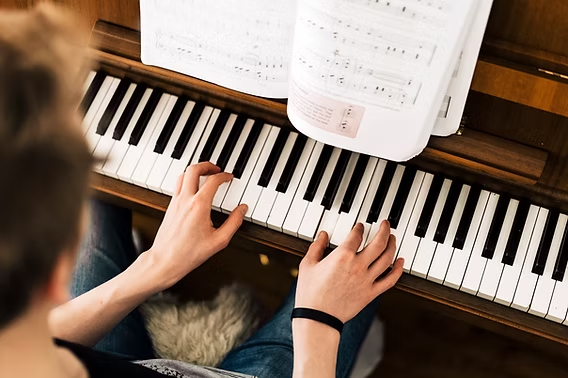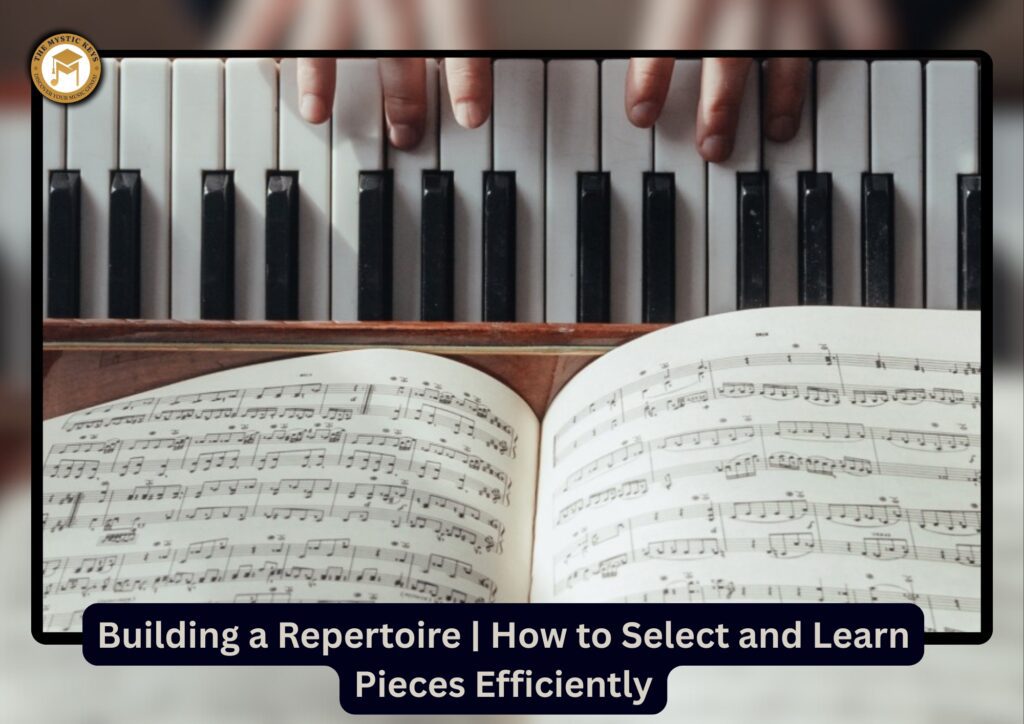Building a Repertoire | How to Select and Learn Pieces Efficiently
Building a repertoire is a crucial part of any musician’s journey, whether you’re just starting out or you’re an advanced player. The repertoire you develop not only showcases your musical abilities but also shapes your musical identity, helping you define your strengths and expand your skills. But how do you select the right pieces for your repertoire? And once you’ve chosen a piece, how can you learn it effectively and efficiently? In this blog, we will delve into the process of building a repertoire, providing practical tips on selecting pieces and learning them in the most efficient way possible.

Understand Your Current Skill Level
Before diving into your repertoire-building journey, it’s important to assess your current skill level. Selecting pieces that align with your technical and musical capabilities will ensure a more fulfilling learning experience.
Beginner: If you’re just starting out, it’s important to focus on simple, foundational pieces that introduce you to basic techniques. These pieces will help you develop a solid foundation in timing, rhythm, and finger placement. Choose songs that are simple but musically engaging, such as folk songs, children’s tunes, or simple classical pieces.
Intermediate: At this stage, you’re becoming more comfortable with your instrument and can start tackling more complex pieces. This could mean exploring more challenging pieces in the classical canon or delving into different genres like jazz, blues, or contemporary music.
Advanced: If you’re an advanced player, you can handle complex and virtuosic pieces that demand high technical precision and emotional depth. Focus on expanding your musical knowledge by selecting works from different styles and traditions to diversify your skill set.
Having a clear understanding of where you are in your musical journey will help you choose pieces that will challenge and improve you, without causing frustration or discouragement.

Set Clear Musical Goals
Having clear goals is vital when selecting pieces for your repertoire. The pieces you choose should align with your long-term aspirations, whether it’s to perform in public, take part in an exam or competition, or simply to enjoy the process of learning and mastering new music.
Performing: If you are learning music to perform, it’s important to select pieces that not only challenge you but also resonate with the audience. Consider the emotional impact of the music, its relevance to your intended performance context, and your personal connection to the piece.
Exams and Certification: For students preparing for exams, you should prioritize pieces from the prescribed syllabus. Follow your exam board’s guidelines for selecting pieces that fit the required levels. While preparing for exams, focus on honing specific skills, such as technical proficiency, expression, and timing.
Personal Enjoyment and Development: If you’re learning music purely for personal enjoyment or self-development, consider pieces that inspire you or evoke strong emotions. Musical enjoyment is often linked to the depth of connection you feel with the music.
Setting clear goals also helps you stay motivated as you navigate through the challenges that come with learning difficult pieces. Break your goals into smaller, manageable tasks, and track your progress along the way.

Choosing Pieces | Finding the Right Balance
When selecting pieces, it’s essential to strike a balance between challenge and attainability. Too easy, and you risk getting bored; too difficult, and you may face frustration. Here are some considerations to guide your selection process:
Technical Challenge: Choose pieces that stretch your technical ability but are not beyond your reach. If you’re working on technique, such as finger independence or hand coordination, select pieces that highlight these skills. However, avoid pieces that are so challenging that they hinder your ability to focus on other aspects of musicianship, like phrasing or expression.
Musical Growth: Select pieces that will help you develop as a musician. If you’re focusing on a particular genre, select works from that genre that offer a variety of styles and techniques. Classical musicians, for example, may want to explore a range of Baroque, Classical, Romantic, and Modern works to expose themselves to a broad range of stylistic nuances.
Repertoire Variety: Having a mix of genres, tempos, and styles in your repertoire will prevent monotony and make your practice more enjoyable. Include a variety of pieces that span different eras, moods, and technical demands. This not only makes your repertoire more versatile but also exposes you to various compositional techniques.
Personal Connection: Music is deeply emotional, and choosing pieces that resonate with you will increase your motivation to practice. Select pieces you love and enjoy playing, as your passion will shine through when you perform them. Over time, you’ll be able to incorporate more challenging pieces, but starting with something you love will set a strong foundation.

Organizing Your Repertoire
Once you’ve chosen your pieces, the next step is to organize them. A well-structured approach to repertoire-building ensures that you continue progressing while maintaining balance and consistency.
Create a List: Write down your chosen pieces in order of difficulty and prioritize them according to your musical goals. You can organize them based on genres, performance readiness, or technical demands.
Track Progress: Keep track of how well you’re progressing with each piece. It helps to keep a practice journal or use apps that allow you to log your practice sessions and reflect on what you’ve accomplished. Tracking progress gives you a sense of achievement and helps you stay focused.
Set Time Frames: Setting a timeline for learning each piece can be helpful. Estimate how much time you will need for each piece based on its difficulty and the time you can devote to practice each week. Break down your practice sessions into sections to avoid feeling overwhelmed by the complexity of the piece.
Revisit and Refresh: It’s important to regularly revisit old pieces to keep your repertoire fresh. Even if you’ve mastered a piece, performing or practicing it periodically ensures it remains sharp and ready for performance. It also helps you notice new musical elements that may have previously gone unnoticed.

Effective Practice Techniques for Efficient Learning
Now that you’ve chosen and organized your pieces, it’s time to focus on how to learn them efficiently. Practice is the key to mastering any piece, but practicing intelligently is what accelerates learning.
Slow Practice: When learning a new piece, it’s essential to practice slowly. This allows you to focus on accuracy and ensures you can execute complex passages correctly before speeding up. Slow practice helps build muscle memory and allows you to master difficult sections before they become ingrained as mistakes.
Chunking: Break the piece down into smaller, manageable sections. Instead of tackling an entire piece in one go, focus on learning smaller sections (or “chunks”) of the music, and practice them repeatedly until they are mastered. Once you’ve mastered each chunk, start piecing them together.
Hands Separately: If you’re learning an instrumental piece, practice each hand separately (for pianists) or individual parts separately (for guitarists or other instrumentalists). This allows you to focus on each hand’s technical challenges before combining them.
Use a Metronome: A metronome helps you develop a consistent sense of timing and rhythm. Start at a slower tempo, and gradually increase the speed as you become more comfortable with the piece. This will ensure you’re playing accurately, even at fast tempos.
Focus on Difficult Sections: Pay extra attention to the tricky passages. Identify the sections that are particularly difficult or require extra attention and isolate them for focused practice. Once these sections are mastered, you can more easily incorporate them back into the piece.
Play for Expression: Technique is important, but expression is what makes music truly come alive. Once you’re comfortable with the technical aspects of the piece, focus on the musicality. Think about phrasing, dynamics, and emotional expression as you play.

Maintain a Balanced Repertoire
As your repertoire grows, you’ll eventually want to add new pieces while maintaining your current ones. Balancing your repertoire ensures that you continue to challenge yourself while still performing older, familiar pieces.
Regularly Add New Pieces: Keep your repertoire evolving by consistently adding new pieces that challenge different aspects of your musical development. However, always maintain a few pieces that are performance-ready so that you can confidently perform at any time.
Set Repertoire Goals: Keep your goals aligned with your growth as a musician. For instance, you might aim to add one new challenging piece every three months, or prepare a specific piece for a recital.
Keep It Fresh: Every now and then, revisit older pieces to breathe new life into them. A piece you haven’t performed in a while may sound entirely different after some time. Approach it with a fresh perspective to rediscover its potential.

Conclusion
Building a strong, diverse, and engaging repertoire is an ongoing process that reflects your growth as a musician. By selecting pieces that are aligned with your skill level, goals, and musical interests, and by using efficient practice techniques, you can build a repertoire that not only challenges you but also keeps you motivated and inspired. A well-curated repertoire will not only make you a more versatile musician but also prepare you for performance opportunities, exams, and the joy of sharing your music with others. Start building your repertoire today, and don’t forget to join The Mystic Keys’ Piano Lessons Online to receive expert guidance and support in your musical journey. Remember, the journey is just as important as the destination.
Related Blogs
The Science of Sight-Reading: How to Read Piano Music Faster
Sight-reading is one of the most essential skills for any pianist. It allows you to play new music on the spot without having to memorize it first. But for many learners, it’s a challenging task that feels slow and frustrating.
How to Develop Finger Independence for Smooth Piano Playing
Developing finger independence is a cornerstone of proficient piano playing. It enables pianists to execute complex passages with precision, expressiveness, and fluidity.
Mastering Piano – Finger Placement Basics from The Mystic Keys
At The Mystic Keys, we emphasize the importance of proper finger placement as the foundation for any pianist’s journey. Whether you’re just starting or refining your technique, mastering finger placement will not only improve your speed and precision but also prevent strain and fatigue.








